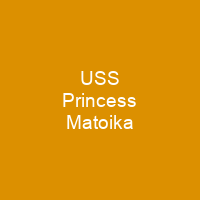USS Princess Matoika: A Tale of Transformation
Imagine a ship that could transform from a grand ocean liner to a warship, then back to civilian service—what an incredible journey! USS Princess Matoika (ID-2290) was just such a vessel. Built in 1900 as SS Kiautschou for the Hamburg America Line, she sailed between Hamburg and Far East ports before being traded to North German Lloyd in 1904.
Renamed Princess Alice, she continued her journey with notable passengers like Howard Atwood Kelly and Hamilton Wright Mabie. But when the United States declared war on Germany in April 1917, the ship’s fate changed dramatically. She was seized by the U.S. Navy and renamed USS Princess Matoika, embarking on a crucial mission to transport troops across the Atlantic.
From Warship to Civilian Service
After her Army transport career ended, the ship continued as a civilian vessel for various companies. She served with the American Palestine Line before being sold and eventually burning in Honolulu Harbor in 1930. Despite her numerous adventures, she was deemed too expensive to repair and was scrapped in Japan in 1933.
From her grand beginnings as an ocean liner to her service during World War I, USS Princess Matoika’s journey is a testament to the versatility of ships and the changing tides of history. Her story is one of transformation, resilience, and the enduring spirit of maritime travel.
A Ship of Many Roles
USS Princess Matoika was more than just a ship; she was a symbol of change and adaptation. From her early days as SS Kiautschou to her final days as City of Honolulu, each phase of her life brought new challenges and opportunities. Her journey is a reminder that even in the face of adversity, there are always ways to find new purpose.
As we reflect on USS Princess Matoika’s remarkable story, it serves as an inspiration for us all—no matter how many times our lives may change, we can always find new paths and purposes. Just like this ship, we too have the ability to transform and adapt in the face of challenges.
USS Princess Matoika’s journey is a powerful reminder that every ship, just like every life, has its own unique story to tell. From grand liners to warships, from transporting troops to carrying passengers on honeymoon trips, her story spans across decades and continents. It’s a tale of resilience, transformation, and the enduring spirit of maritime travel.
You want to know more about USS Princess Matoika?
This page is based on the article USS Princess Matoika published in Wikipedia (retrieved on November 28, 2024) and was automatically summarized using artificial intelligence.








